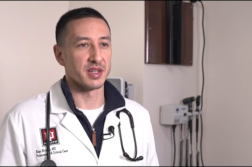CLEVELAND, Ohio (Ivanhoe Newswire) — It strikes suddenly, usually women between the ages of 30 and 50 and no one knows why. Scleroderma is an autoimmune disease that slowly and painfully turns skin and organs into scar tissue. There have been several therapies used to treat the various symptoms, but the very first FDA approved drug is now on the market.
Lynn Bishop, a scleroderma patient shared with Ivanhoe, “I woke up and couldn’t breathe, couldn’t catch my breath, couldn’t carry on a conversation. It was immediate. From there it progressed to a chronic cough. I have constant pain in my hands and my feet. It’s almost like when your skin feels too tight after sunburn.”
The pain Lynn Bishop was feeling, the shortness of breath, was the beginning of scleroderma, a disease that hardens organs and tissues throughout the body. Lynn needed 77 pills a week just to get by.
“It has changed my life,” Bishop revealed.
The once competitive skater and hockey coach could now barely move.
“When you hear there’s no treatment or no cure, to me it made me mad. But, ‘okay, let’s fight.’ like there’s gotta be something. Let’s keep working,” Bishop recalled.
“Unfortunately, nothing makes things go away in scleroderma, but I think we’re now starting to see some hope in scleroderma,” explained Kristin Highland, MD, Director of the Rheumatic Lung Disease Program in the Pulmonary Department of the Respiratory Institute at Cleveland Clinic.
Hope came at the Cleveland Clinic where researchers were testing a new drug that slows the progression of scleroderma in the lungs.
Five-hundred seventy-six patients took the drug Ofev. After 52 weeks, patients had a 44 percent slower loss of their lung function compared to those who received a placebo.
“My lung function test has improved incredibly,” Bishop noted.
Helping Lynn feel better physically and emotionally.
“It was something that gave me hope. I feel like I have my life back,” Bishop rejoiced.
Commonly reported side effects with Ofev include gastrointestinal discomfort, headache, weight loss, and hypertension. This new drug is also being used for people with other lung diseases such as COPD.
Contributors to this news report include: Cyndy McGrath, Executive Producer; Marsha Lewis, Field Producer; Kirk Manson, Videographer; Roque Correa, Editor.
To receive a free weekly e-mail on Medical Breakthroughs from Ivanhoe, sign up at: http://www.ivanhoe.com/ftk
MEDICAL BREAKTHROUGHS
RESEARCH SUMMARY
TOPIC: FIRST FDA APPROVED DRUG FOR SCLERODERMA
REPORT: MB #4752
BACKGROUND: Interstitial lung disease or pulmonary fibrosis is the inflammation of the tissue that surrounds the lungs, blood vessels, and airways. This inflammation or scarring can inhibit breathing causing shortness of breath and coughing. While there is no cure for this disease, there are many treatments effective at slowing it down including medication, oxygen therapy, pulmonary and exercise therapy, and in extreme cases a lung transplant. There is no known way to prevent idiopathic or genetic interstitial lung disease, but other types of the disease can be prevented by not smoking, wearing a respirator around harsh chemicals, and receiving immunizations for flu and pneumonia to protect the lungs.
(Source: https://my.clevelandclinic.org/health/diseases/17809-interstitial-lung-disease)
SCLERODERMA: Scleroderma is an uncommon but painfully chronic autoimmune disease found most often in women age 35 to 55. Why it is contracted is still unknown. It sometimes has genetic markers, but not often and it is not known to be contagious. The disease causes normal tissue to be replaced with dense, thick fibrous tissue and the patient’s immune system to generate too much collagen that gets deposited in the skin and organs. While it most commonly affects the skin, it can also spread to major internal organs and this is its most threating feature. Skin treatments like moisturizer and nitrates like nitroglycerin are often prescribed to prevent skin from breaking down and improve blood flow. However, nitrates can still have side effects such as dizziness, nausea, rapid heartbeat and blurred vision. There are also digestive remedies including over-the-counter and prescribed antacids, proton pump inhibitors and H 2 receptor blockers. Patients should consult their doctor before taking anything for treatment, including over-the-counter medication.
(Source: https://my.clevelandclinic.org/health/diseases/8979-scleroderma-an-overview)
DIAGNOSIS: To be diagnosed with scleroderma the doctor must go through a full family medical history, perform a thorough physical exam and then run several tests. These include blood tests to look for elevated levels of immune factors such as antinuclear antibodies, and pulmonary function tests to measure how well the lungs are functioning. An x-ray or CT scan might also be used to check for lung damage. Gastrointestinal tests can determine if the scleroderma has affected the esophagus and kidney function tests which include measuring blood pressure and protein levels in the patient’s urine. Interstitial lung disease is diagnosed in many ways, including physical exam, lung function test, imaging such as x-ray and CT, bronchoscopy in which the doctor inserts a camera through the nose or mouth to look at the lungs, or even in some cases a lung biopsy.
(Source: https://my.clevelandclinic.org/health/diseases/8979-scleroderma-an-overview/diagnosis-and-tests https://my.clevelandclinic.org/health/diseases/17809-interstitial-lung-disease/diagnosis-and-tests)
FOR MORE INFORMATION ON THIS REPORT, PLEASE CONTACT:
ANDREA PACETTI
CLEVELAND CLINIC
(216) 316-3040
If this story or any other Ivanhoe story has impacted your life or prompted you or someone you know to seek or change treatments, please let us know by contacting Marjorie Bekaert Thomas at mthomas@ivanhoe.com




